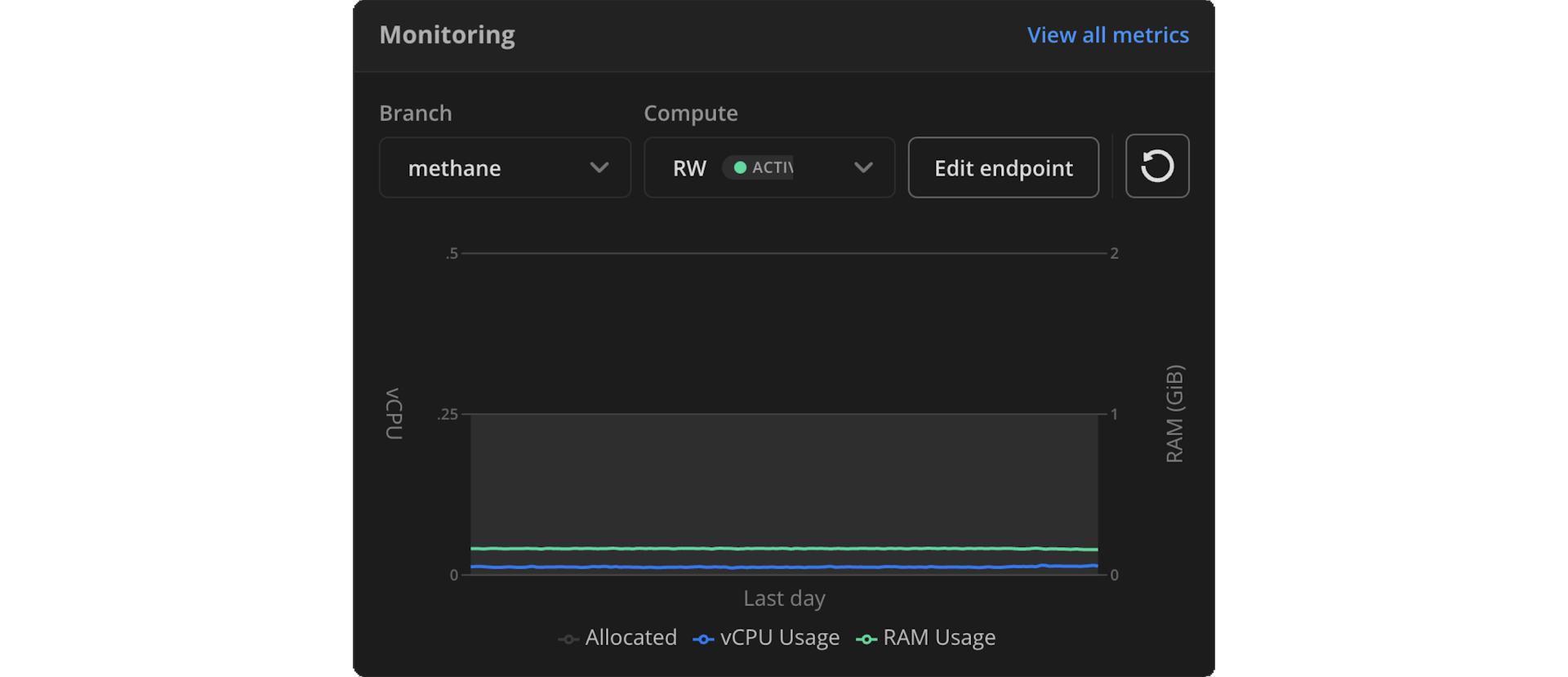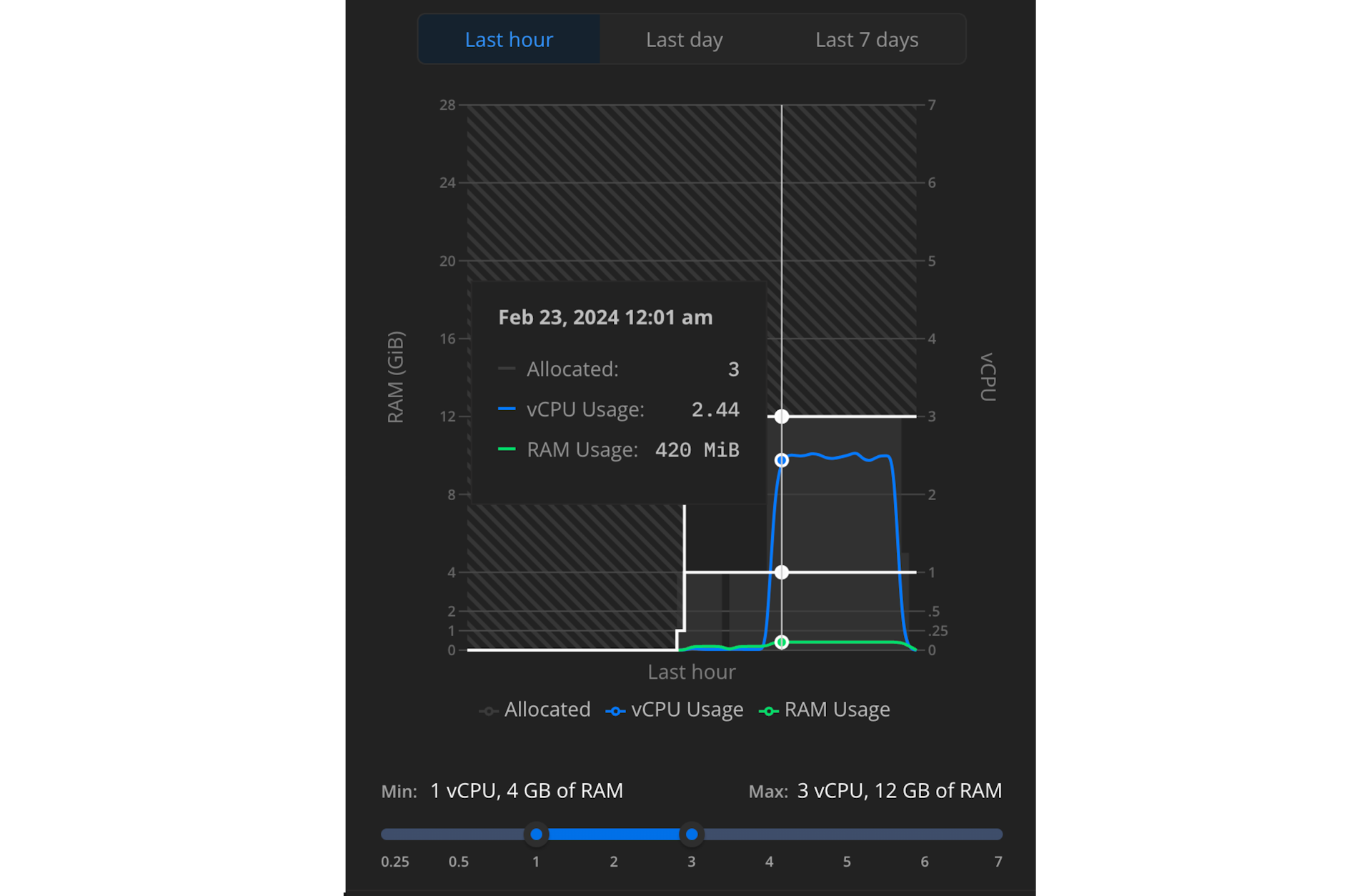Neon is Now Generally Available
April 15th, 2024 was a landmark day for us at Neon as we announced our move to General Availability.
Read more about how Neon is transforming database development, supporting business-critical workloads, and innovating in database scaling and branching in the announcement from our CEO, Nikita Shamgunov.
A New Approach to Database Development
Learn about our journey to General Availability and how Neon is redefining database development.
Along with announcing GA, we also released a host of new features this week:
Monitoring Dashboard
Available from the Neon Console, the Monitoring dashboard provides several graphs to help you monitor both system and database metrics, updated in real time based on your usage data. You can access the Monitoring dashboard from the sidebar in the Neon Console. Metrics include:
- RAM
- CPU
- Database size
- Rows
- Connections count
- Buffer cache hit rate
- Deadlocks
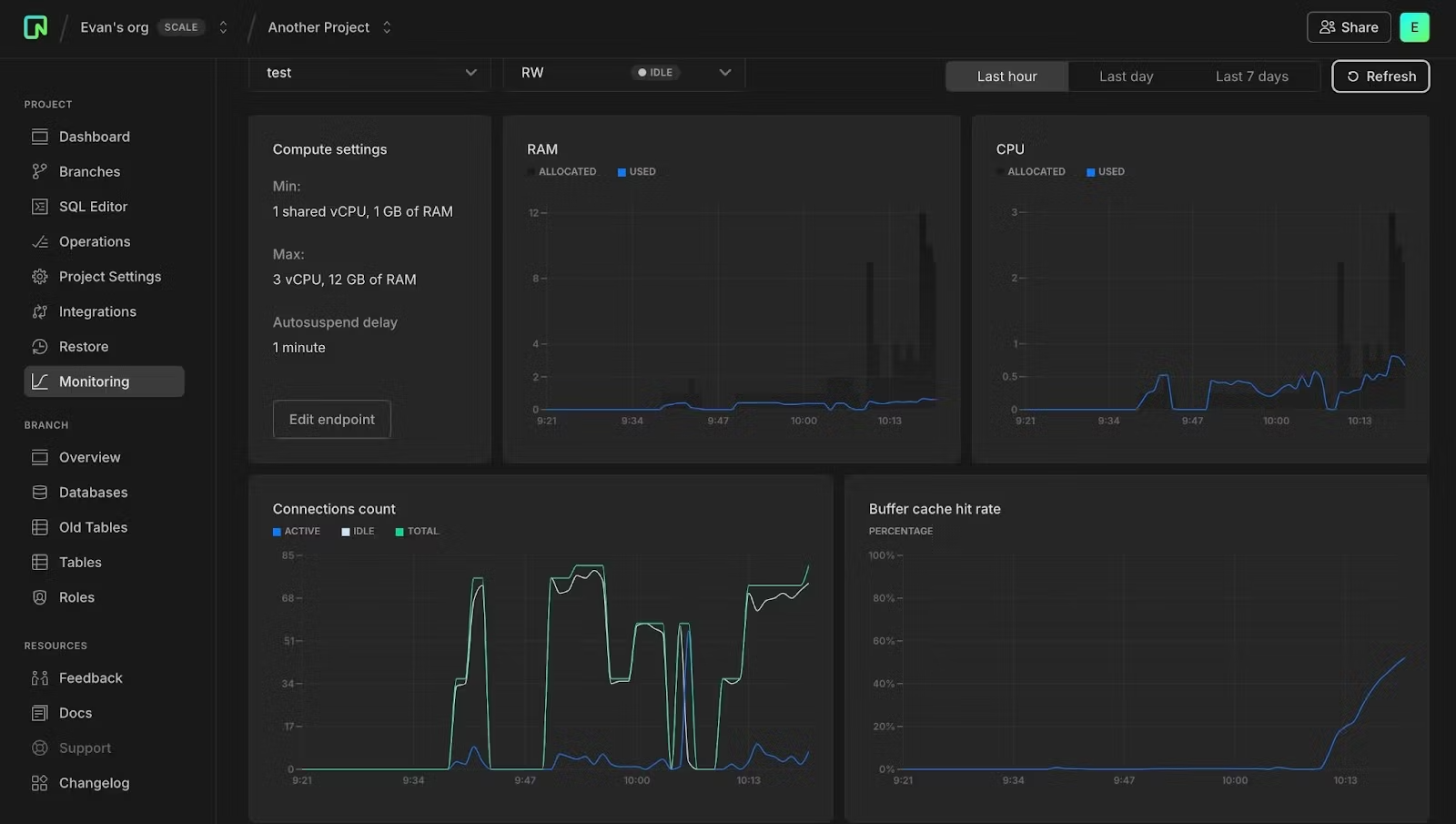
For more information about Monitoring:
- Read the docs: Monitoring dashboard.
- Check out this blog post about Monitoring and our upcoming Organizations support: Announcing Monitoring and Organizations.
Schema Diff
We've added a Schema Diff tool that lets you precisely compare database schemas between different branches for better debugging, code review, and team collaboration.
Available from the Branches detail page as well as part of Time Travel Assist from the Restore page, you can use Schema Diff to compare a branch's schema to its parent or compare any two branches during a branch restore operation.

For more info on Schema Diff, see:
Time Travel from the SQL Editor
To help with data recovery workflows, we've made our Time Travel feature available in the SQL Editor in the Neon Console. Time Travel Assist is also available now on the Restore page, but it's a great feature and we wanted to make it more convenient for you to use, wherever you might need it in the console.
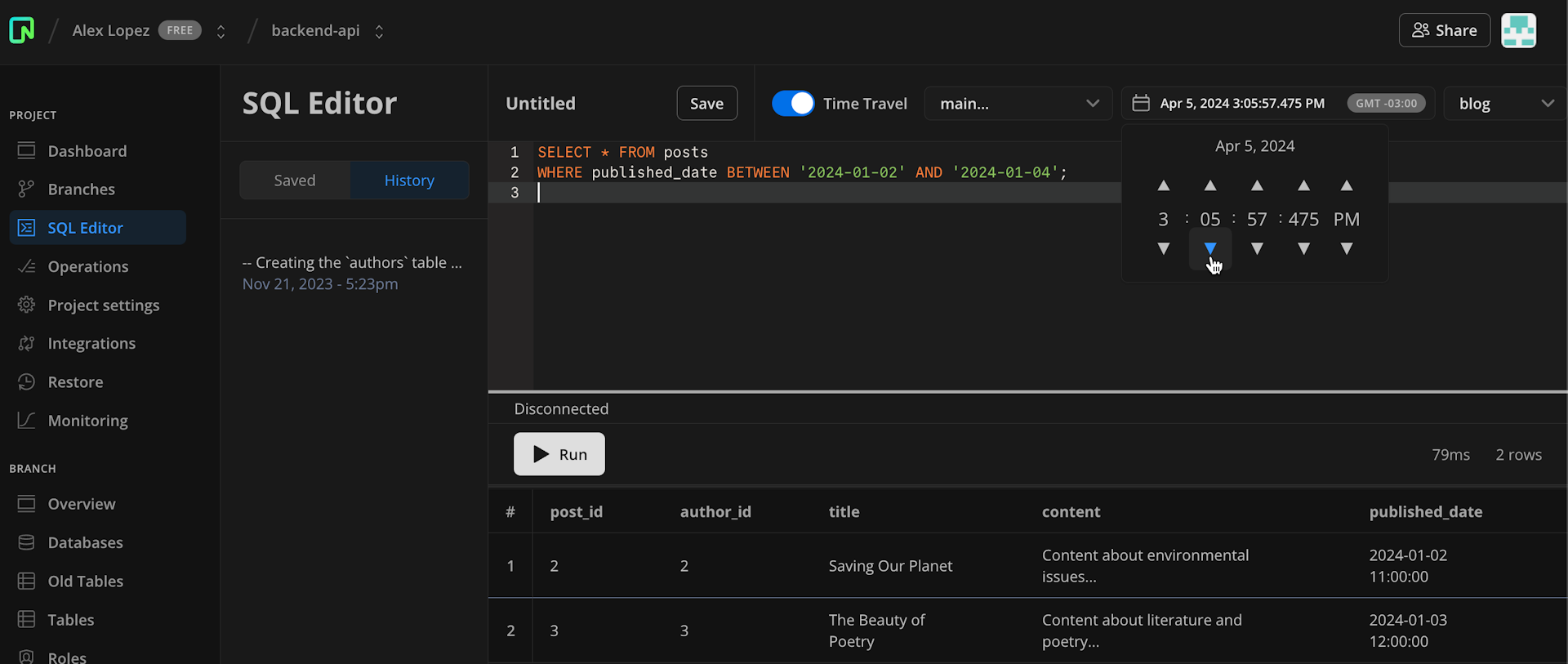
Read more about Time Travel in the SQL Editor:
- Time Travel
- Time Travel tutorial
- And this blog post: Time Travel in the SQL Editor
Support for psql meta-commands in SQL Editor
We added support for psql meta-commands to the SQL Editor in the Neon Console. Meta-commands can significantly speed up your workflow by providing quick access to database schemas and other critical information without needing to write full SQL queries. They are especially useful for database management tasks, making it easier to handle administrative duties directly from the Neon Console.
Here are some of the meta-commands that you can use within the Neon SQL Editor:
\dt— List all tables in the current database.\d [table_name]— Describe a table's structure.\l— List all databases.\?- A cheat sheet of available meta-commands\h [NAME]- Get help for any Postgres command. For example, try\h SELECT.
Note that not all meta-commands are supported in the SQL Editor. To get a list of supported commands, use \?.
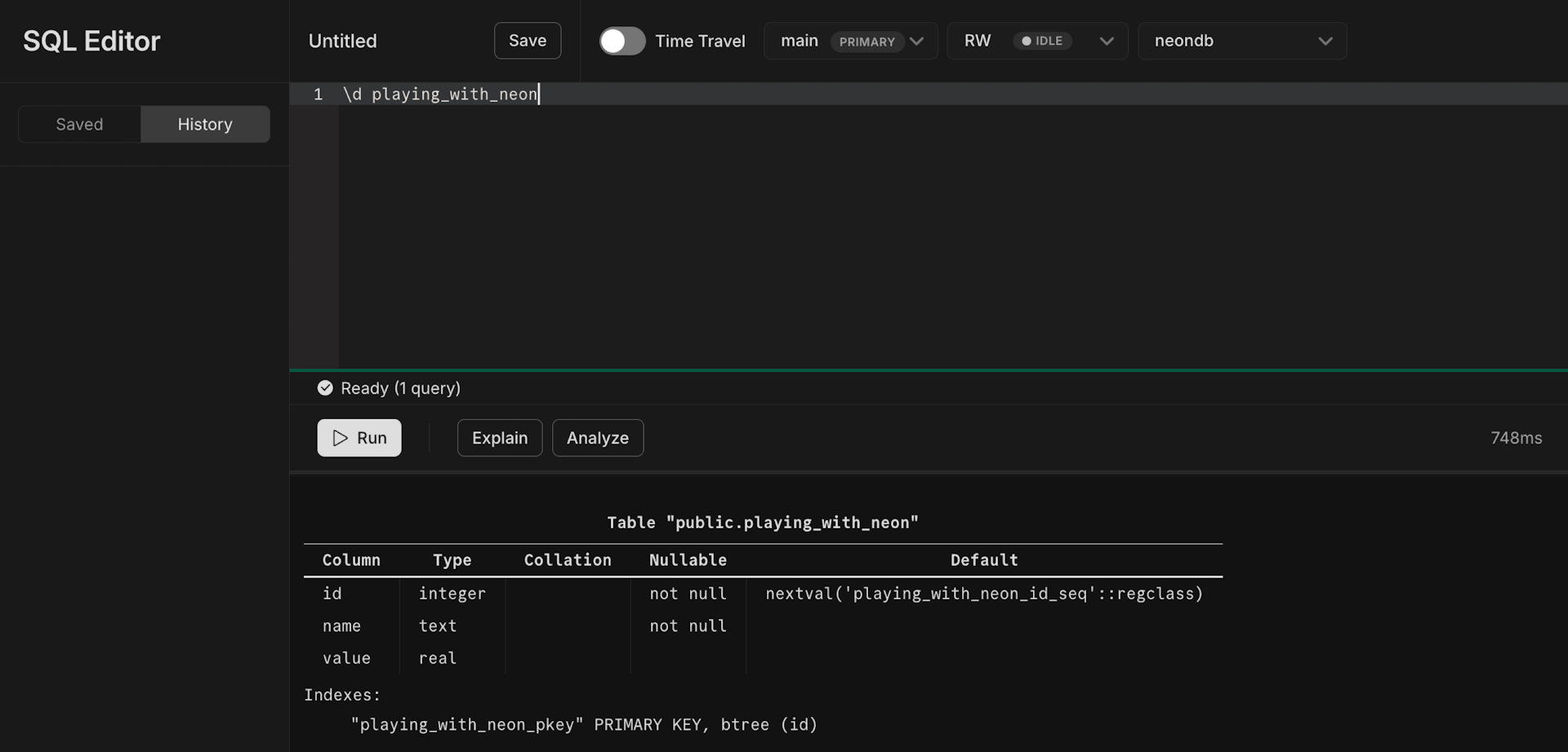
For more info, see:
- The meta-commands section of our Query with Neon's SQL Editor docs page.
- A blog post detailing how our developers brought this functionality out of psql and into the browser: Bringing psql’s \d to your web browser
Join the Neon Early Access Program
Be among the first to explore new features by signing up for the Neon Early Access Program.
Benefits of joining:
- Exclusive early access: Get a first look at upcoming features before they go live.
- Private community: Gain access to a dedicated Discord channel to connect with the Neon team and provide feedback to help shape what comes next.
- Weekly insights: Receive updates on Neon's latest developments and future plans.
Sign Up Now and start influencing the future of Neon!
Protected branches
Users of the Neon Scale plan can now designate a branch as "protected". This status restricts branch access based on IP addresses — only IPs on your project’s allowlist can access a protected branch. Typically, branches containing production or sensitive data are designated as protected.
For details on configuring a protected branch, please refer to our Protected branches guide.
Large database support (beta)
We are currently testing architecture changes to support large databases from 300 GiB to 2 TiB. Access to this feature is limited to paying users by request. If you want to try it out, you can request access from the Beta tab under Project Settings, or use this direct link:
Neon Serverless driver JavaScript Registry (JSR) package
The Neon serverless driver is now available as a JavaScript Registry (JSR) package.
@neon/serverlessThe JavaScript Registry (JSR) is a package registry for JavaScript and TypeScript. JSR works with many runtimes (Node.js, Deno, browsers, and more) and is backward compatible with npm. For example, to install using npm:
npm install @neon/serverlessFor a deeper dive, check out this blog post announcing support for this feature: Neon Serverless Driver on JSR
Fixes & improvements
- You can now view the last active time for a compute endpoint associated with your branch, which is useful for determining which branches you have accessed recently. In the Neon Console, you can view the Last active time on the Branches page or in the Computes section on individual branch pages. Additionally, the Neon API Get a compute endpoint method response now includes a
last_activefield. - The Neon SQL Editor now uses the Neon serverless driver for database connections. If you utilize the Neon IP Allow feature and your public IP address isn't currently on the allowlist, you may encounter a pop-up when you next query your database through the Neon SQL Editor. This pop-up requests permission to add your IP address to the allowlist.
- Resolved a problem with the Neon Vercel Integration where enabling automatic branch deletion resulted in the unintended removal of the
vercel-devbranch after it was renamed. - Resolved an issue where database connections could remain open longer than necessary. We now ensure that connections are forcibly closed if the client has disconnected.
- Fixed a table and selector display issue in the Neon console for long branch names.
- Fixed an SQL Editor issue that occurred when using the project breadcrumb selector from the SQL Editor page.
- Fixed an error in the message displayed after a successful branch reset operation in the console. The "reset from" branch name was not shown.
